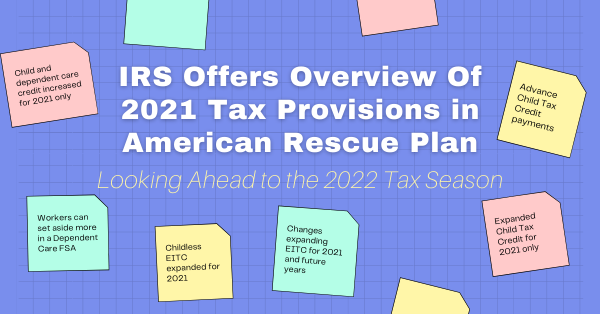IRS Offers Overview Of 2021 Tax Provisions in American Rescue Plan

Looking ahead to the 2022 tax season
The new law increases the amount of the credit and eligible expenses for child and dependent care, modifies the phase-out of the credit for higher earners and makes it refundable.
For 2021, the top credit percentage of qualifying expenses increased from 35% to 50%.
In addition, eligible taxpayers can claim qualifying child and dependent care expenses of up to:
This means that the maximum credit in 2021 of 50% for one dependent’s qualifying expenses is $4,000, or $8,000 for two or more dependents.
When figuring the credit, employer-provided dependent care benefits, such as those provided through a flexible spending account (FSA), must be subtracted from total eligible expenses.
As before, the more a taxpayer earns, the lower the credit percentage. But under the new law, more people will qualify for the new maximum 50% credit rate. That’s because the adjusted gross income (AGI) level at which the credit percentage is reduced is raised substantially from $15,000 to $125,000.
Above $125,000, the 50% credit percentage is reduced as income rises, plateauing at a 20% rate for taxpayers with an AGI above $183,000. The credit percentage level remains at 20% until reaching $400,000 and is then phased out above that level. It is completely unavailable for any taxpayer with AGI exceeding $438,000.
In 2021, for the first time, the credit is fully refundable. This means that an eligible family can get it, even if they owe no federal income tax.
- Child and dependent care credit increased for 2021 only:
- $8,000 for one qualifying child or dependent, up from $3,000 in prior years, or
- $16,000 for two or more qualifying dependents, up from $6,000 before 2021.
- Workers can set aside more in a Dependent Care FSA:
- For 2021, the maximum amount of tax-free employer-provided dependent care benefits increased from $5,000 to $10,500. This means that an employee can set aside $10,500 in a dependent care FSA, if their employer has one, instead of the normal $5,000.
- Workers can only do that if their employer adopts this change. Interested employees should contact their employer for details.
For 2021 only, more childless workers and couples can qualify for the Earned Income Tax Credit (EITC), a fully refundable tax benefit that helps many low- and moderate-income workers and working families. That’s because the maximum credit is nearly tripled for these taxpayers and is, for the first time, made available to both younger workers and senior citizens.
In 2021, the maximum EITC for those with no dependents is $1,502, up from $538 in 2020. Available to filers with an AGI below $27,380 in 2021, it can be claimed by eligible workers who are at least 19 years of age. Full-time students under age 24 don’t qualify. In the past, the EITC for those with no dependents was only available to people ages 25 to 64.
Another change is available to both childless workers and families with dependents. For 2021, it allows them to choose to figure the EITC using their 2019 income, as long as it was higher than their 2021 income. In some instances, this option will give them a larger credit.
The new law increases the amount of the Child Tax Credit, makes it available for 17-year-old dependents, makes it fully refundable and makes it possible for families to receive up to half of it, in advance, during the last half of 2021. Moreover, families can get the credit, even if they have little or no income from a job, business or other source.
Currently, the credit is worth up to $2,000 per eligible child. The new law increases it to as much as $3,000 per child for dependents ages 6 through 17, and $3,600 for dependents ages 5 and under.
The maximum credit is available to taxpayers with a modified AGI of:
Above these income thresholds, the extra amount above the original $2,000 credit — either $1,000 or $1,600 per child — is reduced by $50 for every $1,000 in modified AGI.
Also, the credit is fully refundable for 2021. Before this year, the refundable portion was limited to $1,400 per child.
From July through December 2021, up to half the credit will be advanced to eligible families by Treasury and the IRS. The advance payments will be estimated from their 2020 return, or if not available, their 2019 return.
For that reason, the IRS urges families to file their 2020 return as soon as possible. This includes many low-and moderate-income families who don’t normally file returns. Often, those families will qualify for an Economic Impact Payment or tax benefits, such as the EITC. This year, taxpayers have until May 17, 2021, to file a return.
To speed delivery of any refund, be sure to file electronically and choose direct deposit. Doing so will also ensure quick delivery of the Advance Child Tax Credit payments, later this year.
In the next few weeks, eligible families can choose to decline receiving the advance payments. Likewise, families will also be able to notify Treasury and IRS of changes in their income, filing status or number of qualifying children. Details will be available soon.
The IRS also urges community groups, non-profits, associations, education groups and anyone else with connections to people with children to share this critical information about the Child Tax Credit as well as other important benefits. The IRS will be providing additional materials and information in the near future that can be easily shared by social media, email and other methods.
For the most up-to-date information on the Child Tax Credit and advance payments, visit Advance Child Tax Credit Payments in 2021.
-
- Childless EITC expanded for 2021:
- Changes expanding EITC for 2021 and future years:
- Singles and couples who have Social Security numbers can claim the credit, even if their children don’t have SSNs. In this instance, they would get the smaller credit available to childless workers. In the past, these filers didn’t qualify for the credit
- More workers and working families who also have investment income can get the credit. Starting in 2021, the limit on investment income is increased to $10,000. After 2021, the $10,000 limit is indexed for inflation. The current limit is $3,650.
- Married but Separated spouses can choose to be treated as not married for EITC purposes. To qualify, the spouse claiming the credit cannot file jointly with the other spouse, cannot have the same principal residence as the other spouse for at least six months out of the year and must have a qualifying child living with them for more than half the year.
- Expanded Child Tax Credit for 2021 only:
- $75,000 or less for singles,
- $112,500 or less for heads of household and
- $150,000 or less for married couples filing a joint return and qualified widows and widowers.
- Advance Child Tax Credit payments:




